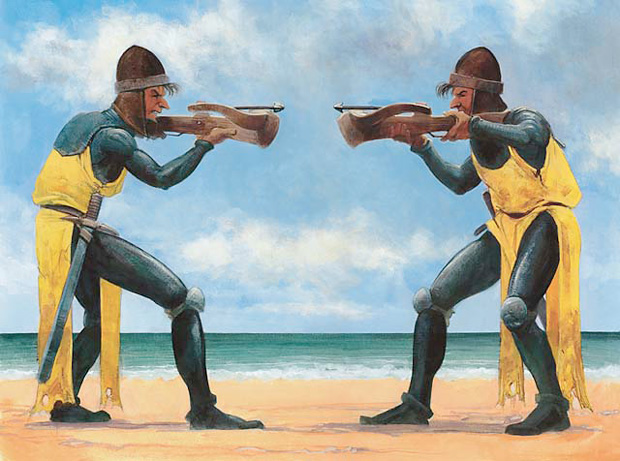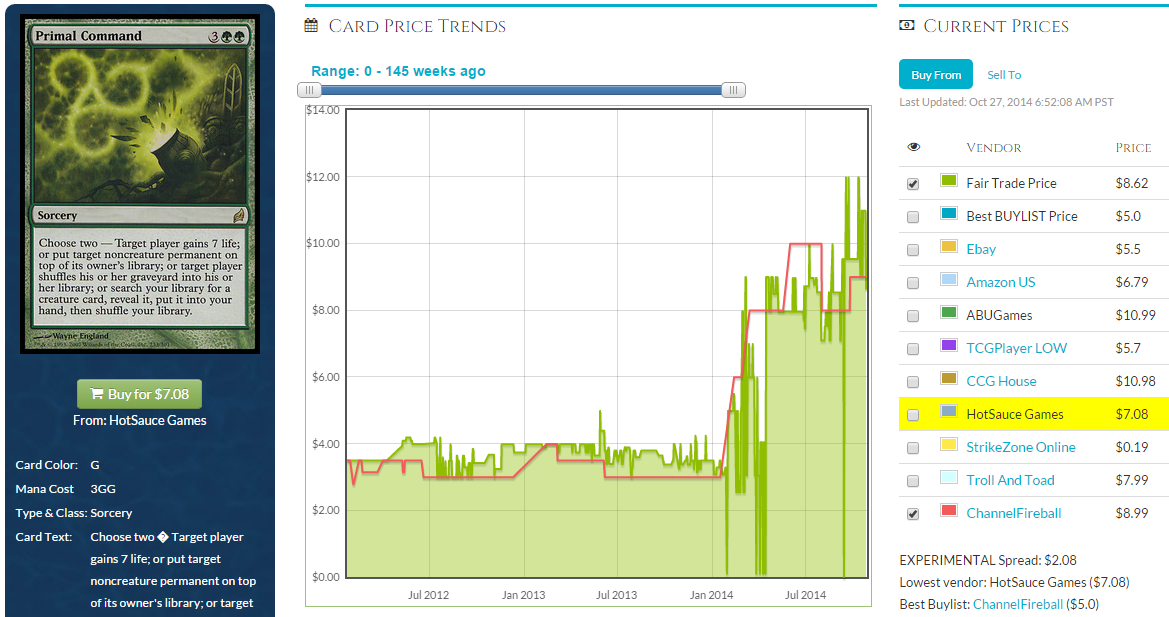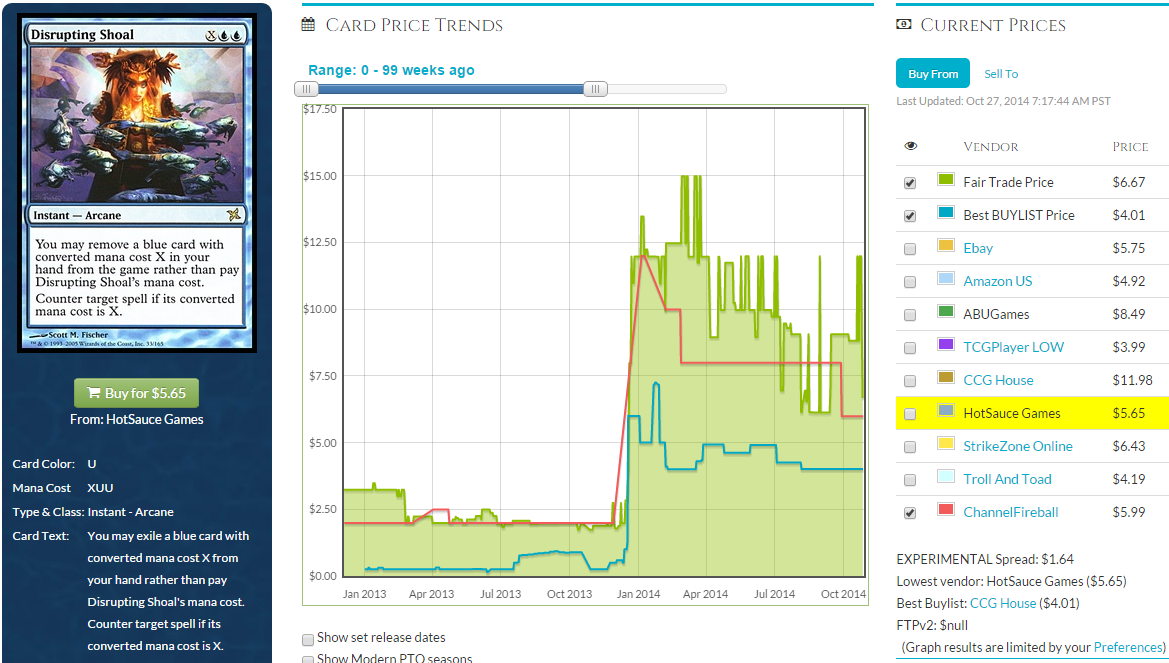By: Travis Allen
There are many ways Magic decks appeal to players. The archetypal GR list that is a pile of nasty monsters, each capable of winning a game when left unchecked, appeals to players who just want to beat the snot out of their opponent with heavy-hitters. Slow UW decks that seek to slowly gain complete control of the game with counterspells, removal, and card advantage appeal to those who want to leverage their play skill over their opponent in a long, drawn out process. Combo decks tickle the fancy of players that want to do cool things very quickly, ending with a critical turn in which the actually or virtually win the game on the spot. Burn decks appeal to sociopaths.
Everyone is drawn more strongly to one type of deck, and some are drawn more strongly than others. A severe spike may find one archetype more interesting than another, but will never play anything other than the deck that gives him or her the best chance of winning. Other players will stick to discard decks exclusively, despite the fact that they’re bad in every format, because they derive perverse pleasure from seeing their opponent empty-handed. Regardless, while everyone has their preferred method of winning, there still exists sexy decks that at the very least will momentarily capture the attention of nearly any player.
Sexy decks are ones that can claim to do something wild and unique. What does sexy in the world of Magic look like? It’s drawing your entire deck in a single turn. It’s a screenshot of your opponent at -20,000 life. It’s killing them on turn zero. It’s hitting the token limit on MTGO. (Which is only 200, by the way. That is a heinously low token limit, and further evidence of how garbage the software really is. What if your opponent is playing some stupid Rhox Faithmender deck and gets to 370 life before you go off and make infinite 1/1 hasty tokens on the last turn of time? “Sorry, even though you win in paper Magic, you lose online.” I’d be pissed.) Sexy is not things like casting Mana Leak or activating Deathrite Shaman to dome someone for two life at the end of their turn.
We’re all momentarily enthralled by sexy decks and sexy plays. It’s human nature. Even if we know that it isn’t good or reliable, it’s still fun to see the extremes of the game. It’s a great reminder of how flexible the world of Magic really is, which is a welcome reminder when staring down the seventh Siege Rhino of the day in round two.
Sexy decks are usually defined by sexy cards. One or two hot cards pull the whole package together and make it look desirable. Birthing Pod is a sexy card. Goryo’s Vengeance is a sexy card. Villainous Wealth is a smoldering, tight black dress in an upscale hotel bar, my-girlfriend-would-be-upset-if-she-knew-what-I’m-thinking-about sexy card. Sexy cards are perfect for letting us entertain our darkest, filthiest, magical christmasy-land fantasies. As such, they’re also prone to exciting our wallets as well.
Work horse cards can be expensive, but it usually takes time to get there. They’re boring and dependable. People buy them because they have to, not because they’re excited to. Sylvan Caryatid, a AAA Standard staple, has taken nearly two months to go from $6.50 to $16.50. Caryatid is powerful and format-defining, but it’s not exactly sexy. Sexy is Glittering wish, which went from $2.50 to $20 in twenty-four hours.
Everyone can appreciate a sexy deck, and sexy decks contain sexy cards. Sexy cards see drastic movements in price.
You go to Pat Chapin for Grixis decks. You go to Craig Wescoe for white weenie decks. Who do you go to for sexy decks? Travis Woo.
It must be the name, because he and I share a love for brews that do very sexy things. I’m playing Jeskai Ascendancy in Modern right now, and I’ve cast more Goryo’s Vengeances in my lifetime than most men. I was trying to get Tooth and Nail to work as soon as Modern was announced, and even when I play real decks like Scapeshift I shoehorn a Gifts Ungiven/Elesh Norn package into them. We both like sexy decks. We both like claiming crazy things. We both like playing on the edge of the format.
Travis Woo enjoys his creations and he wants you to enjoy them as well. When I consider his proselytizing I am reminding of Mike Flores. They both share unbridled enthusiasm for their creations, convinced that they will turn the world of Magic on its ear. Each new deck they unveil is, in their eyes, a game-changer that will Make Them Take Notice, and Set the Format On Fire. Their unadulterated exaltation of their creations is a key component of their public identity. Neither of them writes about a deck and says “This seems decent in testing and I’m looking for ways to make it better.” They say things like “cash in your 401k to buy Primal Commands because this deck is unreal.”
The excitement Woo exudes when discussing and showing off his creations, along with the fact that they often utilize cards that have been sitting in dusty boxes for years, has a tendency to generate powerful hype when a new model rolls into the showroom floor. Stream a few games of sacrificing Summoner’s Egg at the end of T3 and then killing your opponent with the Emrakul that was underneath and people get into a tizzy. Cries about Woo breaking it circulate amongst the echo chamber, and before you know it there are no copies of the eponymous card left on TCGP. This has become known as the Woo Effect.
Without fail, these brews end up being far too unstable to reliably perform in large events. A few diehards will actually sleeve them up and take them to local Modern events where they’ll realize that UR Delver is just too real a deck and too miserable to play against for the concoction to succeed. The deck is desleeved, the marquee cards put into the trade binder, and the player returns to Channel TWoo eagerly awaiting the next revolution.
Do you know what isn’t sexy? Slowing your combo down to play around removal. Boarding out the turn-one kill and instead beating down with a few 2/1s. Getting disrupted by a turn one Thoughtseize and spending the rest of the game durdling around while your opponent does you in with a Tarmogoyf. Consistency isn’t sexy. Losing to sideboard cards isn’t sexy. Low prices aren’t sexy.
Waves of Aggression is the most recent recipient of the TWoo fervor machine, and the impetus for me to write this article. It was $.50 to a dollar on CFB for the longest time, yet now I can barely find a copy under $6.
This is hardly the first time this is happened, and I’m sure it won’t be the last. Let’s look back at the last few times a card has seen such a drastic rise in response to inclusion in a TWoo article.
The next most recent occurrence that I can recall was Summoner’s Egg. In typical TWoo fashion, this image was included in the article in which he writes about Summoner’s Egg.
This stands in contrast to the price graph.
Like Waves of Aggression, it hovered in the $.50 to $1 range before he wrote about it. The spike here was slightly less, only hitting roughly $4, but the fall more severe: back to $1.50 CFB; up a whopping $.50 from where it started.
Following Egg is a pair of green cards that seemingly held great potential. I seem to recall TWoo advising you take out loans to buy into Primal Command.
Primal Command faired a bit better. I was on the train on this one as I’m a sucker for a good green card. I remember picking them up between $2.75 and $3.25. The best buylist is as high now as it’s ever been at $5. It’s worth noting that while the spike on Primal Command first occurred in January, it wasn’t until May that the buylist actually got to $5. I spent weeks watching Command, hoping it would rise enough in price that it would be worth cashing out. It took months before there was actual realized profit to be had. I guess at this point, eight months later, I’ve made a profit of $2 a copy. Hooray?
Genesis Wave saw roughly comparable success. Copies were $2 on CFB right up until January 1st, when they jumped all the way to $7. The buylist didn’t follow immediately though. It ended up hitting $4 a copy, but not until February, and it only lasted two or three weeks. It dropped to $3 shortly after, and remains there today. I can recall shipping a few sets for $20 on eBay, but I think all said and done I made maybe $10 a playset. You’re certainly pleased with that, although the window of opportunity to do so was short; maybe a two or three days at most. There was no way you could have moved more than a handful of sets in that time period.
Finally we come to what would have been the most lucrative of TWoo’s recommendations: Disrupting Shoal.
Disrupting Shoal was $2 before Ninja Bear Delver Whatever, and managed a respectable $12 afterwards. A 500% increase is for sure a healthy profit margin. The buylist didn’t do a great job of keeping up, spending only days north of $5, but the private market would have been good to you. The heydey didn’t last forever, but NM copies are about $5-$6 on TCG right now which is still more than the $2 you would have paid for them.
Living End is perhaps the card most connected with Woo, although I don’t think he can claim responsibility for its price today. According to his CFB bio he T8’d with it in 2010, but the price spike isn’t until mid-2013, shortly after Modern Masters was released. While he certainly put the card on the map, buying in when he “broke” it would have meant a three year wait on getting paid.
What’s the takeaway from all of this? First I want to remind you of the costs of flipping cards.The short version of the story is that a card has to see a substantial rise in price in order for you to make any profit whatsoever, and even then it can be difficult to make more than minimum wage.
Next I want to point out that really, with the exception of Disrupting Shoal, you really wouldn’t have made much money buying cards Woo recommends. If you bought the night the article was published, before any movement had occurred whatsoever, you stood a chance to make a profit. It would have required not only being the first in line at TCGP, but also not having your order cancelled, receiving the cards before the hype died down, and actually getting them sold somewhere. If you were a day late to buy your copies or dragged your feet listing them after they arrived, any margin of profit would have been entirely erased.
Keep in mind too that the buylists almost never move quickly with these sorts of spikes. Vendors know that these are flashes in the pan, and therefore demand will die off rapidly. They aren’t in a rush to buy your Waves of Aggression if they expect that nobody is going to want to buy the card a week later. This means that in order to out your copies you’ll need to go to somewhere like eBay or TCG. While you often sell the cards for more money in those venues, there are also greater transaction costs, greater risk, and they require a larger time investment.
I also notice that the two cards that sustained the largest percentage increases, Disrupting Shoal and Living End, are both free spells. Perhaps the lesson here isn’t to watch what Woo is playing, but rather just to assume any free spell will eventually be broken. (I personally have a pile of Soul Spikes that’s just waiting for the day.)
It’s easy to look at cards like Waves of Aggression spike so hard and wish that you had gotten in on the train, but the stark reality is that it’s nearly impossible to turn a profit from these types of spikes unless you were already holding a pile of copies when it happened. Without copies in-hand on day zero, your best approach to Woo spikes is to observe bemusedly while putting your MTG funbux somewhere more reliably lucrative.
On a separate topic, I’ll be a bit quiet for the next two months. Expect only two articles or so out of me between now and the first of the year. Don’t fret though; I fully intend to return full time in January, hopefully with tales about buying and selling across the sea in Tokyo. I’ll also still be active on Twitter – @wizardbumpin – to the chagrin of all of my followers.
Track your collection's value over time, see which cards moved the most, track wishlists, tradelists and more. Sign up at MTGPrice.com - it's free!







Travis Woo is the Peter Molyneux of deck creation huh? Sounds about right.
Enjoy your time away from MTGFinance! I will miss these articles – you will be back in time for Spoiler Season for Fate Reforged. Before you go – what should a newly price-conscious mtg player look to spend on the next set (middle of a bloc, last of a rotating group before new standard)
How much you spend is product of your goals. Do you want to be able to play every Standard deck? Do you want to build a single deck and ride it for a few months? That type of decision will help you figure out what you need to pick up in terms of cards.
If you’re asking how many packs/boxes you should crack, the answer is “only what you need to for prerelease and weekly drafting.” Opening packs for funsies is like scratching lottery tickets. It’s certainly exciting, but you “should” open $0 worth.
You are most likely right about opening packs. It’s one of my vices, I go in on a case with a couple of friends if the set seems good usually and we crack the packs on release day at our store – it is very fun! But I am looking to scale back I think. I am going to ride Abzan out probably for this season – it looks and plays so well.
I had previously gotten pretty much playsets of anything in standard that I could put a deck together for – but I probably really shouldn’t. I sold out of my Mono blue deck last season just at its peak and didn’t really look back. I will probably keep enough cards moving forward to hit Jeskai and Abzan throughout the season, but then I get tempted with so many other builds – it’s how they get ya!
Regular @ Victory Comics in Falls Church, VA
If you enjoy cracking packs with your friends, go hog wild. (Do pack wars though, it’s the best way to crack them next to drafting.) Don’t delude yourself into thinking it’s a good value decision though. Like I said, it’s like lottery tickets. If you value the entertainment factor of the randomness then they’re “worth” it, but it will never be “worth” it strictly on a dollar-for-dollar basis.
Snake oil salesmen have been plying their trade since there have been fools with money to spend.
I think I’ve figured out why Birthing Pod is locked at $10. The moment someone buys it out, people will sell and trade their copies out of fear that it is speculated to be banned. Pod is the deck to beat in modern now, so there’s just enough people picking it up to play it. People don’t want to pay more than $10 for a card that is on the banhammer’s anvil.
Why the art for clone and not the actual art for evil twin? http://gatherer.wizards.com/Pages/Card/Details.aspx?multiverseid=229965, shame. Regardless, I’m not sure why people keep buying into Twoo’s hype, I’m pretty sure even he knows that his decks are never the next deck to warp modern, I guess maybe people are afraid he eventually will break modern and don’t want to miss out?
In my two minute search I couldn’t find full size art for that card. If you find it I’ll change it.